



Feed Outlook - January 2011
Feed grain production for 2010/11 is estimated at 330.0 million tons, down 2.2 million from last month, according to the latest report from the USDA Economic Research Service.Domestic changes this month are based in part on USDA’s National Agricultural Statistics Service's Crop Production 2010 Summary and January Grain Stocks reports. Feed grain production for 2010/11 is estimated at 330.0 million tons, down 2.2 million from last month as lower corn production more than offsets an increase in sorghum output. Projected 2010/11 corn ending stocks are lowered 86 million bushels as a small increase in imports only partly offsets the lower production estimate. At 5.5 per cent of projected usage, ending stocks would be their lowest since 1994/95. Projected season average prices are raised for corn, sorghum and oats. December 1 hay stocks per roughage-consuming animal unit (RCAU) are down from last year but silage production per RCAU is up as the decline in RCAUs outpaces that for silage. US and foreign 2010/11 coarse grain production and ending stocks are reduced this month. Forecast world coarse grain ending stocks for 2010/11 are down 20 per cent from the previous year and are lower than in 18 of the previous 20 years.
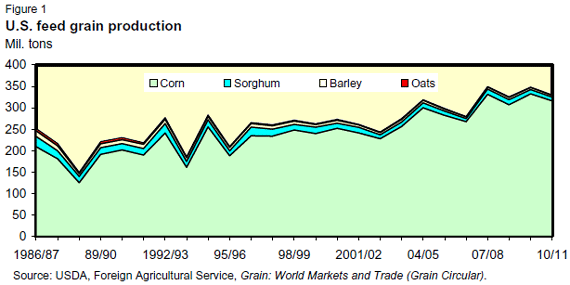
Domestic Outlook
Feed grain supplies down for 2010/11
US feed grain supplies for 2010/11 are forecast at 380.3 million metric tons, down two million from last month and down 17.5 million from last year. The 2010 corn crop is estimated lower this month but the sorghum crop is higher. Barley and oats production are unchanged. Imports are raised slightly to 2.1 million tons, reflecting an increase in corn imports. Beginning stocks are unchanged at 48.1 million tons.
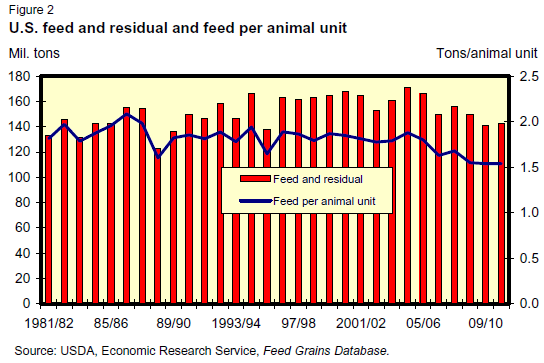
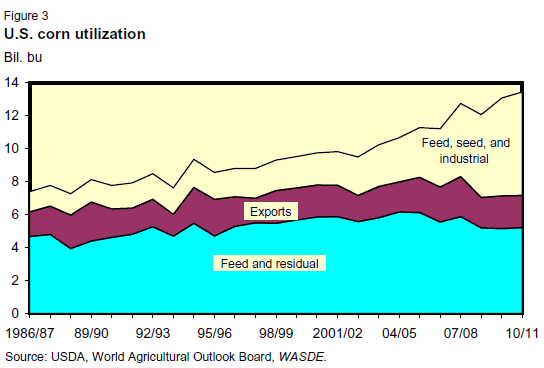
Total feed grain use is projected slightly higher at 357.7 million tons this month. Domestic use of the four feed grains is raised 0.4 million tons this month to 304.1 million. This increase is the result of higher projected feed and residual use for sorghum. Feed grain exports for 2010/11 are lowered slightly this month to 53.6 million tons, as sorghum exports are reduced. The decrease in feed grain supplies combines with an increase in domestic use to lower expected ending stocks 2.2 million tons to 22.5 million. In 2009/10, ending stocks for the four feed grains totalled 48.1 million tons.
Feed and residual use for the four feed grains plus wheat converted to a September-August marketing year is down 2.3 million tons to 142.6 this month because of decreases in projected feeding of corn and wheat. These are partially offset by higher sorghum feeding. Grain-consuming animal units are forecast at 92.7 million, up from 92.5 million last month, due to increases in beef and broiler production in 2011, which is partially offset by lower pork production. The increase in beef production reflects placements of cattle during the fourth quarter 2010 that will be ready for slaughter during mid-2011. Broiler production was increased due to relatively heavy bird weights. Feed and residual use per animal unit is lowered to 1.54 tons, down from 1.57 tons last month.
Small supply and use changes were made for feed grains in 2009/10; production is lowered 0.4 million tons to 348.6 million. Domestic use is lowered to 294.9 million tons with a 0.5-million-ton reduction in feed and residual use to 137.1 million. Ending stocks are unchanged at 48.1 million tons for 2009/10. These changes are mainly due to lower estimated corn production for 2009/10.
Corn yield trimmed for 2010/11
US corn production for 2010/11 is decreased 93 million bushels this month to 12,447 million bushels. This month’s decrease reflects a decrease in the average corn yield, down 1.5 bushels per acre to 152.8 bushels per acre. The decrease in yield outweighs an 183,000-acre increase in harvested area to 81.4 million acres.
Projected feed and residual use is lowered 100 million bushels to 5,200 million, reflecting lower-than-expected September-November disappearance as indicated by December 1 stocks. September-November corn food, seed and industrial use was higher than the same months last year, partly reflecting increased use for sweeteners and starch. Corn used for high-fructose corn syrup (HFCS) in September-November 2010 was 126.2 million bushels, up from 119.1 million bushels during the same months in 2009. Corn used for glucose and dextrose during September- November 2010 was 65.1 million bushels, up from 61.8 million bushels during the same months in 2009. In September-November, corn used for starch production was 66.0 million bushels, up from 59.8 million bushels during the same period last year.
Corn used for fuel alcohol production from September-November 2010 is estimated at 1,218 million bushels, up from 1,058 million in the same period last year. Record ethanol production in December indicated by The US Energy Information Administration’s weekly data boosted first quarter corn use and resulted in a marketing year increase of corn used for fuel by 100 million bushels to 4,900 million. As the industry approaches the blend wall, exports of ethanol have strengthened during 2010, providing an additional outlet for US production.
US corn exports for 2010/11 remain unchanged this month at 1,950 million bushels. Total projected corn use for 2010/11 is also unchanged at 13,430 million bushels, up from 13,066 million in 2009/10. Corn ending stocks for 2010/11 are expected to be 745 million bushels, down 88 million bushels from last month as the decrease in production is only partly offset by a five-million-bushel increase in projected imports. Ending stocks are down 963 million bushels from last year. The stocks-to-use ratio is projected at 5.5 per cent, the lowest since 1995/96 when it dropped to 5.0 per cent.
With decreases in supplies, the 2010/11 season average price received by farmers is projected 10 cents higher on both ends to $4.90 to $5.70 per bushel.
Changes are also made this month to the 2009/10 corn supply and use tables. Corn area planted and harvested is lowered slightly, which decreases production 18 million bushels to 13,092 million. These revisions result in an offsetting 18-million-bushel decrease in 2009/10 feed and residual use to 5,140 million bushels.
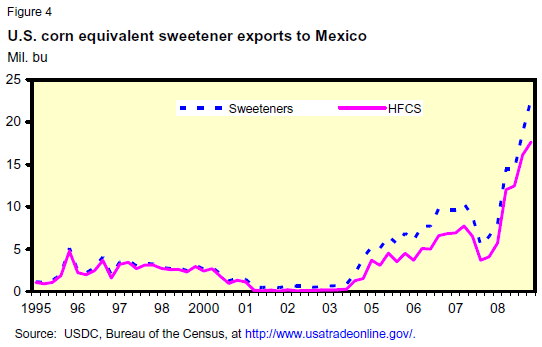
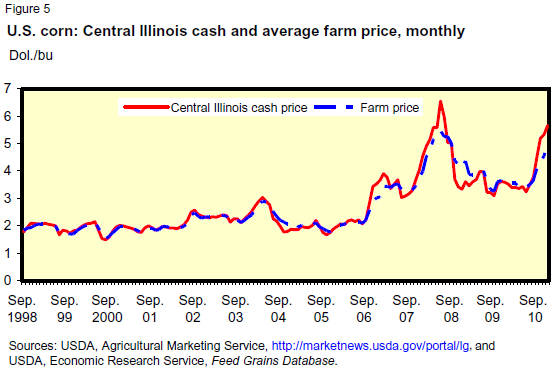
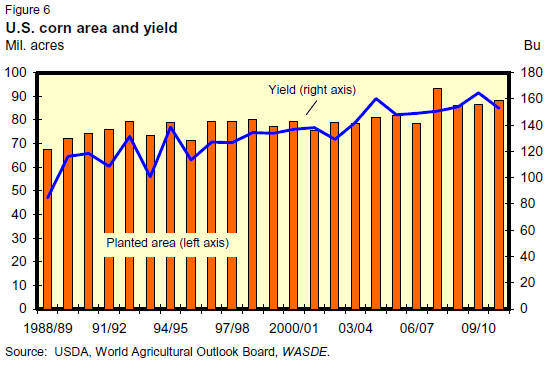
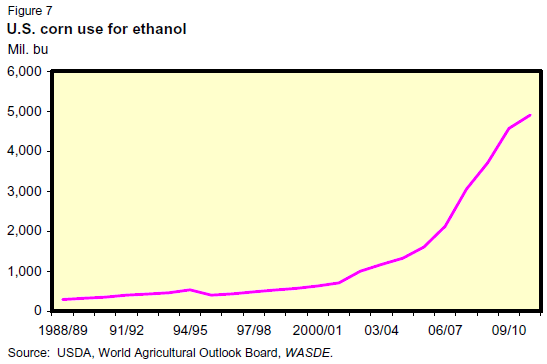

Sorghum production up in 2010/11
US sorghum production for 2010/11 is estimated at 345 million bushels, up seven million from last month but down 38 million from 2009/10. The upward revision to this year’s production is based on increased harvested acreage. Harvested acreage is increased 150,000 acres to 4.8 million. The average sorghum yield is 71.8 bushels per acres, down 0.7 bushels per acre from last month but up 2.4 bushels from the previous year.

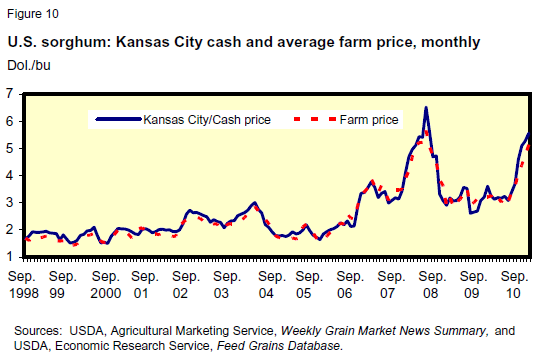
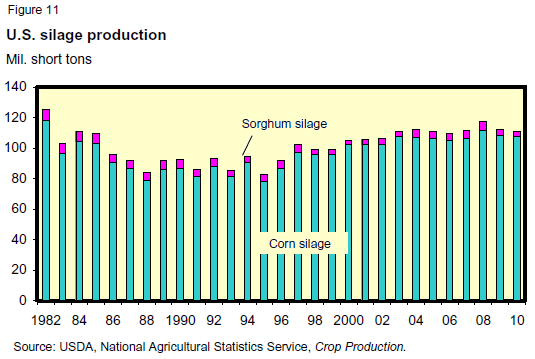
Forecast sorghum feed and residual use for 2010/11 is increased 20 million bushels this month. At 110 million bushels, this year’s feed and residual use is down from 140 million bushels last year. Food, seed and industrial use remains unchanged this month at 90 million bushels. Exports are lowered 10 million bushels to 150 million based on increased domestic use. With increased use more than offsetting the increases in supplies, ending stocks for 2010/11 are projected two million bushels lower to 37 million.
The season average farm price is projected 20 cents higher on both ends of the range to $5.10 to $5.90 per bushel. Prices received by producers have risen since the start of the marketing year, supported by rising values for corn.
Barley use lowered slightly
Total 2010/11 domestic use for barley is lowered this month to 205 million bushels, reflecting lower feed and residual use which is down five million bushels to 45 million. Ending stocks are projected up five million bushels at 91 million.
Forecasted barley prices received by farmers are unchanged this month at $3.70 to $4.10 per bushel.
Oats prices increase
There are no changes to the oats supply and use this month.
Based on prices received to date, the season average farm price is projected five US cents higher on both ends of the range to $2.20 to $2.40 per bushel.
Hay disappearance up in 2010/11
Stocks of all hay stored on farms totaled 102 million tons on 1 December 2010, down five per cent from a year ago. Disappearance of hay from May-December 2010 totalled 64.3 million tons, compared with 62.5 million tons for the same period a year ago. Compared with stocks on 1 December 2009, hay stocks decreased in most of the states. Stock decreases in many areas were attributed to lower production and cattle producers feeding hay earlier than normal due to dry conditions.
Roughage-consuming animal units (RCAU) in 2010/11 are estimated at 69.08 million, down from 70.25 million in 2009/10. Despite reduced hay supplies, lower RCAUs decrease hay stocks per RCAU to 1.48 tons, down from 1.53 tons last year.
All hay production totaled 146 million tons for 2010, down four per cent from the 1 October forecast and down one per cent from the 2009 total. Area harvested is estimated at 59.9 million acres, up slightly from both the 1 October forecast and from last year. The average yield at 2.4 tons per acre is down 0.12 tons from October and down 0.04 tons from the previous year.
Production of alfalfa hay and mixtures in 2010 is estimated at 67.9 million tons, down five per cent from the previous forecast, and down four per cent from 2009. Harvested area, at 20.0 million acres, is down ofur per cent from the 1 October forecast and six per cent below the previous year. The average yield is 3.40 tons per acre, 0.04 tons below the October forecast but 0.05 tons above 2009.

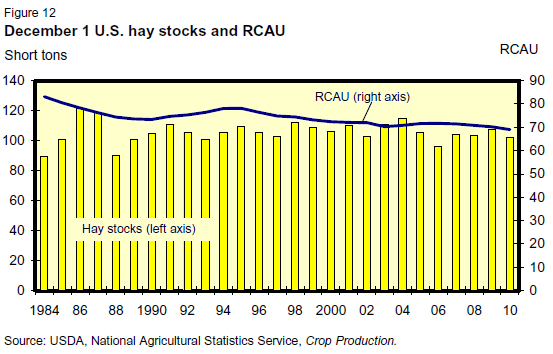
Other hay production totalled 77.7 million tons, down 4 per cent from the 1 October forecast but up one per cent from 2009. Area for harvest, at 39.9 million acres, is up three per cent from October and up four per cent from last year. The average yield is estimated at 1.95 tons per acre, down 0.13 tons from October and down 0.04 tons from last year.
Corn silage production is estimated at 107 million tons in 2010, down one per cent from 2009. The US corn silage yield is estimated at 19.28 tons per acre, tying the record set in 2009. Acreage harvested for corn silage is estimated at 5.57 million acres, down one per cent from a year ago. Sorghum silage production is estimated at 3.42 million tons, down seven per cent from 2009. Area harvested for sorghum silage is 273,000 acres, up seven per cent from the previous year. Sorghum silage yields averaged 12.5 tons per acre, down 2.0 tons per acre from last year. Total silage per RCAU in 2010/11 is estimated at 1.603 tons, down from 1.593 tons in 2009/10.
In the first eight months of the 2010/11 hay marketing year (May-April), hay prices have averaged 2.5 per cent higher than in 2009/10. Alfalfa hay prices averaged $118.25 per ton, 3.3 per cent above prices a year earlier during May through December. Other hay prices averaged $96.84 per ton, 1.7 per cent below prices a year earlier during May through December.
International Outlook
World coarse grain production, use and ending stocks reduced
Global coarse grain production in 2010/11 is projected to reach 1,083.5 million tons, down 5.1 million this month. While the US decline is the largest single country reduction, foreign production is down 3.0 million tons to 753.2 million. Corn accounts for the largest part of the foreign production decline, down 2.4 million tons to 499.8 million. Oats, rye and sorghum contribute to the overall reduction but foreign barley production is projected up 0.5 million tons to 120.9 million. Argentina’s barley production is up 0.4 million tons to 2.3 million as favourably dry harvest conditions boost harvested area expectations and preliminary yield reports confirm an excellent crop. The UK reported a slightly larger barley crop, boosting EU production as well.
Argentina suffered dry, hot conditions during December and early January in some key, high-yielding corn areas, such as northern Buenos Aires, southern Santa Fe, Entre Rios and parts of Cordoba. While much of the crop was not yet in the critical reproductive stage, enough of the crop was far enough along that yield prospects are reduced, dropping forecast production 1.5 million tons to 23.5 million.
In Indonesia, a second year of excessive rains is dampening corn yield prospects, reducing production 0.4 million tons to 8.0 million. Turkey reported lower-than-expected corn yields, reducing production 10 per cent to 3.6 million tons. Croatia reported reduced harvested area, more than offsetting increased yields, trimming production 0.1 million tons to 2.1 million. Excessive rains and flooding in Colombia reduced corn production prospects slightly. These reductions swamped a 0.1-million-ton increase for Russian corn based on better-than-expected yields for the drought-damaged crop.

Russia also reported low oats and rye yields, reducing rye production 0.4 million tons to 1.7 million and oats production 0.3 million tons to 3.2 million. The historical series for oats in Brazil was revised, and reduced area trimmed production. Brazil’s sorghum production is also reduced.
World coarse grain use in 2010/11 is forecast down 2.1 million tons this month to 1,122.9 million tons. Global feed use is cut 3.3 million tons, with the largest decline for US corn. Foreign coarse grain consumption is cut 2.5 million tons, with a 1.1-million-ton reduction in feed use.
Foreign corn disappearance is down 1.8 million tons this month. South Korea corn use is down 0.5 million tons this month as it is expected to shift some corn feeding to wheat due to ample feed wheat supplies available from Australia and Canada. Turkey’s corn use is trimmed 0.3 million tons because of reduced production. Indonesia’s corn use is trimmed 0.1 million tons with reduced production, while Russia is increased a like amount due to increased production. The largest reduction in world corn disappearance this month is caused by local marketing year exports being cut by almost one million tons more than local marketing year imports. This reduces apparent use.
Global oats and rye use are trimmed this month, mostly for Russia due to reduced production. Sorghum projected use is reduced slightly this month for Brazil and Mexico, but these are more than offset by the US increase. World barley use is increased, mostly due to larger expected use in Ukraine, Brazil, Argentina and Azerbaijan.
Global coarse grain ending stocks for 2010/11 are reduced 3.1 million tons this month to 158.8 million, with foreign stocks accounting for a decline of 0.9 million. The largest foreign change is for Australia, down 0.3 million tons for barley as export prospects are increased. Corn stocks prospects are reduced 0.2 million tons each for Canada, Turkey and the Philippines. Imports for Turkey and the Philippines are reduced this month, while exports are increased for Canada. Sorghum ending stocks are trimmed 0.1 million tons each for Brazil and Mexico due to tighter supplies. These and smaller changes more than offset slightly increased stocks projected this month for Argentina, Brazil, China, and EU barley and for EU corn.
Forecast world coarse grain ending stocks for 2010/11 are down 20 per cent from the previous year and are lower than in 18 of the previous 20 years. Although global coarse grain stocks in 2003/04 were lower than those forecast for 2010/11, the stocks as a share of use was 15.1 per cent, higher than the 14.1 per cent projected this year. In 2006/07, world coarse grain stocks were smaller but the stocks as a share of use were 13.9 per cent, not much lower than the 2010/11 projection.
World corn trade reduced, US exports unchanged this month
Global corn trade forecast for 2010/11 is reduced 1.1 million tons to 90.9 million. South Korea is expected to import 0.5 million tons less at 8.5 million, with most of the reduction offset by increased imports of feed-quality wheat. Turkey's projected corn imports are cut 0.4 million tons to 0.3 million as uncertainty surrounding biotech regulations inhibit trade. Corn imports for Brazil and the Philippines are trimmed 0.2 million tons each due to the slow pace of purchases. These reductions more than offset a 0.3-million-ton increase for Indonesia caused by reduced production prospects and small increases for the United States and Argentina.
Trade year 2010/11 corn export prospects for Argentina are cut 1.0 million tons to 14.0 million this month, due to reduced production. Turkey’s corn export prospects are cut 0.25 million tons to 0.05 million as tight supplies and biotech regulations disrupt normal trade patterns. Croatia’s corn export prospects are trimmed slightly while Egypt's are nudged up.
US corn exports for 2010/11 (October-September) remain forecast at 50.0 million tons, up slightly from 49.9 million the previous year. Although the pace of sales in recent weeks has not been strong, the large carry-in of outstanding sales at the beginning of the year have supported shipments and commitments. Census data show October-November 2010 corn shipments up four per cent from a year earlier. Grain/Inspections data for December indicate corn exports up 37 per cent from the previous year’s slow pace. Moreover, as of 30 December 2010, corn outstanding sales reached 11.8 million tons, up from 11.2 million a year ago. Reduced corn production prospects in Argentina indicate the late-season drop-off in US exports will be limited.
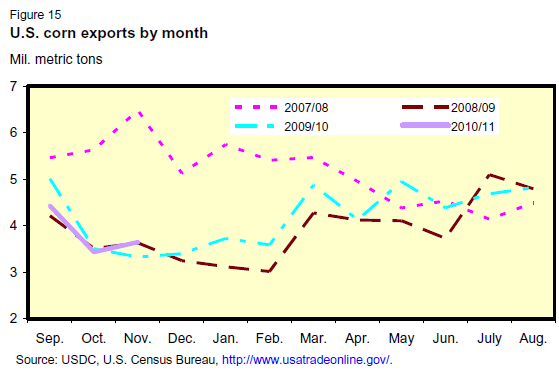
US 2010/11 sorghum export prospects are trimmed 0.2 million tons to 3.8 million (down 10 million bushels to 150 million bushels for the local marketing year). The pace of sales and shipments has been significantly slower than a year ago due to tight US supplies. Mexico’s imports are trimmed by a like amount.
Global barley trade is boosted 0.7 million tons this month to 16.8 million tons, mostly due to increased imports announced by Syria. Syria’s 2010/11 imports are boosted 0.5 million tons to a forecast 0.8 million. Imports for Brazil and China are also increased this month based on the pace of purchases. Export prospects are increased for the EU, Argentina and Australia.

Further Reading
| - | You can view the full report by clicking here. |
January 2011








